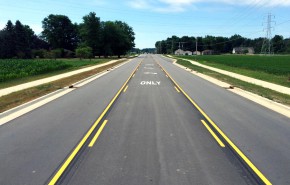Reducing runoff pollutants with rain gardens has captured national interest, local and statewide funding opportunities, and community pride and participation. Rain gardens are designed to filter (cleanse) and reduce the volume of stormwater, allowing more time to seep into the ground. Unlike a pond or water garden, a properly designed rain garden holds water only during and for about 4-48 hours following a rain or storm event.
GAI–Ft. Wayne designed two demonstration rain gardens to mitigate water runoff problems at Croninger School in Allen County, Indiana, as part of Catching Rain in Fort Wayne, a City Utility initiative and educational program. “Demonstration” rain gardens become living examples and educational workshops at locations accessible to the public. The Croninger rain gardens were completed in May 2012, with the enthusiastic planting assistance of elementary students, and teachers.
Runoff Pollutants. Stormwater collects particles like road sediment and salt, pet waste bacteria, fertilizers, and pesticides during runoff. The polluted stormwater then washes across impervious surfaces (i.e., roads, rooftops, sidewalks, and driveways) and, untreated, enters storm sewers and eventually our lakes, streams, ponds, and wetlands.
Without natural drainage at Croninger School, where runoff from residential backyard flooding contributed to the problem, low shallow areas held water year round, rendering them unmowable, a breeding ground for mosquitoes, and an overall maintenance and health concern.
More than a Perennial Garden. The two rain gardens designed by GAI measured 400’ long and 40’ long x varying contour and design widths. Landscape specialists carefully selected porous planting media, small perennial native plants, and plants with deep fibrous roots—all chosen for their adaptability, low maintenance, sustainability, and natural habitat appeal. GAI placed sod on the side slopes to provide an additional “vegetative” filter. Decorative benches, stone paths, and stone edging invited interaction and a relaxing and educational venue for the public.
Community Involvement is Contagious. The City of Fort Wayne kicked off the Rain Garden Incentive Plan at their annual GreenFEST in Spring 2009, with an admittance fee of a canned good or non-perishable food item donated to Community Harvest of Northeast Indiana—and community education and contribution began with the kickoff. A goal of 1,000 residential and demonstration rain gardens in Fort Wayne was set that day. GAI feels especially honored to have designed two of the first 20 demonstration rain gardens toward Fort Wayne’s Rain Garden Incentive goal.
Community retailers, residents, and organizations provided music, workshops, speakers, food, and sustainable product door prizes. From Do-It-Yourself residential rain gardens to engineered undertakings like those designed by GAI, community participation is ongoing. In July 2012, Wells Fargo Community Banking and Wells Fargo Environmental Affairs in partnership with the Wells Fargo Foundation established a grant to cover interpretive signage at Fort Wayne’s rain gardens. Learn more about Fort Wayne’s Green Infrastructure Initiative to “improve the quality of our three rivers and the streams that feed them.” Visit http://www.catchingrainfw.org/.
GAI Community Focus. GAI welcomes the opportunity to make a positive difference in the communities where we live and work. Whether the projects are large, small, or somewhere in between, our impact on community is the primary focus of our engineering and environmental professionals. Demonstration rain gardens are attractive and educational, benefit our communities, reduce municipal costs, and improve water quality—stormwater management at its best.
{gallery}feature_stories/rain_garden/gallery{/gallery}
For more information, please contact Assistant Vice President Mark Jesse (GAI-Ft. Wayne Office) at 260-969-8822 x3522, or email m.jesse@gaiconsultants.com.
References
Clayton, R., & Schueler, T. (1996). Design of stormwater filtering systems. Ellicott City, MD. Center for Watershed Protection.
Clemson University Cooperative Extension Service (2012), Demonstration Rain Garden in Cleveland Park, Clemson Cooperative Extension. Digital file http://www.clemson.edu/extension/county/greenville/programs/horticulture/raingarden.html, accessed July 2012.
Obropta, Christopher C. (2008). The Demonstration Rain Garden, Journal of Extension, 46(2), April 2008. Digital publication, http://www.joe.org/joe/2008april/tt3.php, accessed July 2012.
© University of Connecticut | NEMO is a program of the Center for Land Use Education and Research (CLEAR).
Digital file http://nemo.uconn.edu/successes/case_studies/haddam_demo/demosite_rain_garden.htm, accessed July 2012.
© Rutgers, The State University of New Jersey (2011). Water Resources Program, Rain Gardens. Digital file http://www.water.rutgers.edu/Rain_Gardens/RGWebsite/raingardens.html, accessed July 2012.


